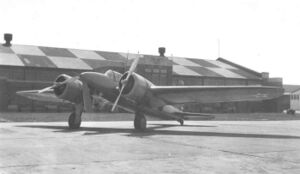Engineering:Curtiss XA-14
| XA-14 | |
|---|---|

| |
| Curtiss XA-14 | |
| Role | Ground attack |
| Manufacturer | Curtiss Aeroplane and Motor Company |
| First flight | 17 July 1935[citation needed] |
| Status | Prototype |
| Primary user | U.S. Army Air Corps |
| Number built | 1[1] |
| Developed into | A-18 Shrike |
The Curtiss XA-14 was a 1930s United States airplane, the first multi-engine attack aircraft tested by the United States Army Air Corps. Carrying a crew of two, it was as fast as the standard pursuit aircraft in service at the time.
Design and development
Originally built as an in-house venture as the Curtiss Model 76, powered by two experimental Wright XR-1510 radial engines, flight testing was sufficiently impressive that after the USAAC appraisal the Model 76 was returned to Curtiss and fitted with two 775 hp (578 kW) Wright R-1670-5 Whirlwind engines with two-position variable-pitch propellers. This configuration was accepted by the Army with the designation XA-14.[2] It had standard Army markings with the serial number 36-146.[3]
The Model 76 was of all-metal construction with an oval section semimonocoque fuselage, described as "pencil slim". The XA-14 was extensively tested, at one stage being fitted with a 37 mm (1.457 in) cannon in the nose.[4]
In July 1936, 13 developed versions, re-engined with two 850 hp (630 kW) Wright R-1820-47 Cyclone 9-cylinder radials, were ordered into production as the Y1A-18.[3]
Specifications (XA-14)
Data from Curtiss Aircraft 1907–1947[5]
General characteristics
- Crew: 2
- Length: 40 ft 6 in (12.34 m)
- Wingspan: 59 ft 6 in (18.14 m)
- Height: 11 ft 0 in (3.35 m)
- Wing area: 530 sq ft (49 m2)
- Empty weight: 8,875 lb (4,026 kg)
- Gross weight: 11,656 lb (5,287 kg)
- Powerplant: 2 × Wright R-1670-5 14-cylinder two-row air-cooled radial piston engines, 775 hp (578 kW) each
- Propellers: 2-bladed two-position variable-pitch propellers
Performance
- Maximum speed: 243 mph (391 km/h, 211 kn) at sea level
- Cruise speed: 222 mph (357 km/h, 193 kn)
- Service ceiling: 28,000 ft (8,500 m)
- Rate of climb: 1,690 ft/min (8.6 m/s)
Armament
- 4 × 0.30 in (7.62 mm) M1919 Browning machine guns forward-firing
- 1 × 0.30 in (7.62 mm) machine-gun on a flexible mount in the rear cockpit
- 650 lb (290 kg) bombs in an internal bomb-bay
See also
Related development
Aircraft of comparable role, configuration and era
- Bristol Blenheim
Related lists
- List of military aircraft of the United States
References
- Notes
- Bibliography
- Eden, Paul and Soph Moeng, eds. The Complete Encyclopedia of World Aircraft. London: Amber Books Ltd., 2002. ISBN:0-7607-3432-1.
- Fahey, James C. U.S. Army Aircraft 1908-1946. New York: Ships and Aircraft, 1946.
- Fitzsimons, Bernard, ed. The Illustrated Encyclopedia of the 20th Century Weapons and Warfare, Vol. 21. London: Purnell & Sons Ltd. 1967/1969. ISBN:0-8393-6175-0.
- Swanborough, F. Gordon and Peter M. Bowers. United States Military Aircraft Since 1909. New York: Putnam, 1964. ISBN:0-85177-816-X.
- Wagner, Ray. ‘’American Combat Planes, Third Enlarged Edition.’’ Garden City, New York: Doubleday & Company, Inc. 1982 ISBN:0-385-13120-8.
 |

